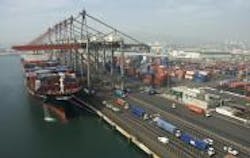“There’s a constant appetite for energy and that will drive up oil prices in the future. As a result of high energy prices, transportation will cost more. That will drive a lot of industrial manufacturing back to North America from China. And if it comes back to North America, it will create more demand for freight – and so more demand for trucks.” –Sandeep Kar, global director-commercial vehicle research, Frost & Sullivan
It’s one of the tantalizing prospects of higher oil prices, which is usually something that only elicits nothing but gasps and groans from the U.S. populace: The return of manufacturing operations from overseas (read as China) to North American shores.
The reason for such “return migration” to the minds of experts such as Sandeep Kar, global director-commercial vehicle research for consulting firm Frost & Sullivan boils down to a simple chain of facts: high energy prices drives up the cost of transportation, and as transportation gets more expensive, it eliminates the costs savings generated from moving manufacturing operations halfway around the world to benefit from what we politely call “lower labor costs.”
The risk factors surrounding the use of far-flung manufacturing sites to produce goods for U.S. consumers are growing in other areas as well, according to a new report from global consulting entity PricewaterhouseCoopers (PwC), entitled Achieving Excellence in Production and Supply.
The firm contends that the global manufacturing industry must act now to protect and prepare their supply chain matrix against what its analysts call a “ticking time bomb” of instability across five critical areas: skills and talent, addressing lifecycle opportunities, linking demand planning with the rest of the supply chain, identifying and acting on supply chain risks, and the need for stronger collaboration between suppliers and customers.
“Supply chains and the manufacturing industry have been on a roller coaster ride, hit by skyrocketing prices of oil and commodities, high levels of debt, weak demand and tight credit,” noted Barry Misthal, who heads up PwC’s global industrial manufacturing group.
“The reality is many [manufacturers] do not know who their high risk suppliers are or where the cracks and loose chinks are in their supply chains,” he warned. “With the current volatility of geopolitical, economic and financial markets, businesses need to research their risk areas and mitigate where they can in areas such as life cycles, demand planning and skill shortages.”
Misthal pointed to the chaos created within global supply chains due to the Japanese earthquake and tsunami earlier this year as a particularly poignant example of the new risks. In particular, Xirallic, a popular pigment which gives cars a pearly shine, was manufactured at just one factory in the world, the Onahama plant near the Fukushima-Daiichi nuclear power station in Japan.
The plant had to close causing some car makers to slow production or halt completely. Though it is now back on track for recovery, the impact of this single plant in an interview earlier this year being shut down highlights the need for manufacturers to engage in what Misthal called “a radical re-think” about current business strategies.
Part of such a “re-think” might mean the relocation of manufacturing operations closer to the end users of their goods – something Max Fuller, co-chairman of U.S. Xpress Enterprises, said in an interview earlier this year is occurring now throughout North America, largely in Mexico but in the U.S. as well.
That could be a very good thing for trucking is this trend picks up speed – and for our country as a whole as well.
